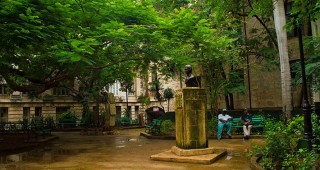
Convento e Iglesia del Carmen LH  3
3
In 1923, members of the order of the Carmelites purchased a lot on the corner of Avenida del Presidente Menocal and Neptuno, where first they created a provisional chapel and later erected the majesti …
 EclecticOpen: Lauds: 8am; Vespers: 6:30pmInfanta entre Neptuno y Concordia
EclecticOpen: Lauds: 8am; Vespers: 6:30pmInfanta entre Neptuno y Concordia 
Parque y Casa Alejandro de Humboldt LH  3
3
In this 19th-century house, the scientist Alejandro de Humboldt installed his instruments and botany and mineral collections while ensconced here 1800-1801. Restored as a museum in 1997, the five exhi …

Hotel Ambos Mundos LH  3
3
This 1920s eclectic hotel is best known for being described by Hemingway as “a good place to write.” He stayed here during the 1930s and this is where he wrote his chronicles on fishing and the first …
 EclecticAdmission: FreeObispo #153, esq. a Mercaderes, Habana Vieja
EclecticAdmission: FreeObispo #153, esq. a Mercaderes, Habana Vieja 
Museo Nacional de la Danza LH  3
3
Opened in October, 1998, to coincide with the 50th anniversary of the National Ballet of Cuba, this museum features objects mainly from Alicia Alonso’s collection, as well as documentaries, costumes a …

El Torreón LH  3
3
Recently restored, El Torreón or as locals call it Castillito (literally, small castle), built in 1649 with blocks from the San Lázaro Quarry (where José Martí was sentenced to forced labor), was part …

Casa de Los Pelícanos LH  3
3
Although modified by later reconstructions, this Art Nouveau apartment building has preserved its beautiful wooden door carved with floral motifs and flanked on both sides by two slender stone pelican …

Sinagoga Adath Israel de Cuba LH  3
3
Built in 1959, this is the oldest and only orthodox synagogue in Cuba. The building has a room for praying that can seat 600 people, a mikve and a hall. Opening hours: Shajarith: 8am (daily except on …

Hotel Sevilla LH  3
3
After the city walls began to be demolished in 1863, construction works for a luxury hotel began on El Prado Avenue, one of the city’s most popular promenades. Manuel López and Urbano González, owners …
 OtherAdmission: NoneTrocadero 55, entre Prado y Zulueta
OtherAdmission: NoneTrocadero 55, entre Prado y Zulueta 
Parque de los Mártires Universitarios LH  2
2
This cement park was built in 1967 to honor university students involved in Cuba’s independence struggles. The most notable element, located by the most important entrance, can be interpreted a fist, …

Cárcel de la Habana LH  2
2
Up until 1834 there were no prisons in Havana. Back then, prisoners were crammed together in a small area on the Palacio de Gobierno’s basement. With this in mind, Lieutenant General Miguel Tacón, Gov …
